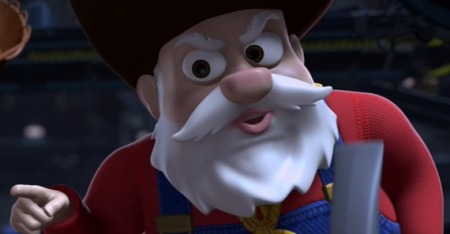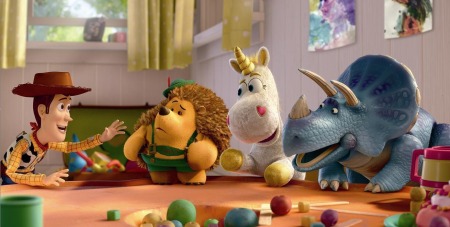Robert here, closing out the first season of my series Distant Relatives, (where we look at two films, (one classic, one modern) related through theme and ask what their similarities/differences can tell us about the evolution of cinema) with the second part of this two part special.

Last week in PART ONE we discussed how the great sorrow or rejection by God or a loved one in Bergman’s universe is equvalent to rejection by the child owners (god/loved one amalgams that they are) of the Toy Story films. And when those owners have put their childish things aside, what do the toys do? Where do they find meaning in their lives? Now... PART TWO.
Hooray, you're old!
In Ingmar Bergman’s film Wild Strawberries, Professor Isak Borg is being recognized with an honorary degree. As he approaches this honor he is forced to look back on his life and wonder what it all means. Similarly in Toy Story 2, Woody is on the brink of recognition of his own, a place in a museum as the valuable toy he is. This is the opposite of what Woody fears will happen when Buzz arrives or what happens to so many spouses in Ingmar Bergman scripts. Instead of being discarded for their antiquity they’re being celebrated for it. And yet this alone does not give them great joy and purpose.
In Bergman films, losing a sense of meaning usually results in considerable tragedy. Max von Sydow’s villager Jonas in Winter Light meets a tragic end after his doubt in God is confirmed by the local parish preist. Liv Ullman’s actress in Persona goes mute, and while the reasons are a mystery, the sense is that she’s somehow come out of place in the world. Perhaps the most dramatic example of this is Von Sydow again,. His father figure Tore from The Virgin Spring reacts at the death of his daughter, his light, his legacy, his reason for being, with such an outburst of violence it continues to inspire tales of cinematic vengance to this day.

So it is with Stinky Pete. The prospector has never been taken out of his box. He’s never been played with by a child. His entire life has been leading up to recognition as an artifact, not a play thing. When it becomes apparent that he won’t achieve this recognition he reacts with violence. Buzz Lightyear himself goes through a similar trial. When, in the original Toy Story he finally learns that he is not a space man, he goes a bit bonkers. While his conflict is more internal, it is still evidence that the absence of purpose equals the presence of sorrow. So what brings Buzz back? To be sure, Woody’s insistence that the love of a child is a noble cause plays a part. But more actively, his ability to help his fellow toys is the true catalyst to his new self actualization.
I get by with a little help...
Buzz learns what Antonius Bloc of The Seventh Seal learns when he allows his new friends to escape the clutches of death, that in the absence of spiritual meaning, friendship and love are still present and still the noblest goals by which we can aspire to. It seems like too Capra-esque a message for a Bergman film (although keep in mind the reason why most Bergman’s are heavy is because his characters spend most of their time, denying or rejecting this fact). Whatever ache you feel at the loss of your god’s or partner’s love, fulfillment comes from knowing that love is an endless resource. This is what finally brings Professor Isak Borg peace as he recalls the absence of love in his life. It’s not his upcoming honor, it’s the realization that he has affected old friends, can still make new ones, and can reunite the marriage of his son an daughter-in-law. This is the realization that Woody has and that which he is able to bring to Jessie and Bullseye.

Togetherness and family is the running theme of the Toy Story films for this reason. It is what gives the toys their sense of purpose. It is what keeps them always chasing after each other. And it is the comfort where they turn when finally faced with certain death. It is also family that saves them from this death (utilizing the trilogy’s most memorable false god, The Claw and turning it from a force for indifferent chance into one of salvation). Consider that the happily ever after coda of the Toy Story trilogy finds the toys playing not with any owner, but with each other. And so all is well right? Except, this revelation that love conquers all isn’t always so easily realized. Sometimes our heroes have to go to hell and back to see it.
The flames of Sunnyside
For a filmmaker whose films deal in death, Ingmar Bergman has never gone over to the other side of existence, not literally at least. But the juxtaposing worlds of Fanny and Alexander, the loving home life and unforgiving realm of the evil minister are as close as you can come to the heaven and hell. The Toy Story 3 parallels are obvious. Bishop Vergerus and Lotso’ Huggin Bear are cut of the same cloth. Supposedly kind leaders of peace filled worlds, they are in fact dark lords who rule over their minion-filled empires with an iron (or plush) fist. These are the hells of eternal torture and damnation where our characters are supposedly doomed forever due to their own lapses of loneliness. But family comes to save them and heaven awaits in the form of a loving, playful, existence that affords them all the joy, with none of the oppressiveness of life’s endless excesses. Interestingly both “heavens” are theater environments, declarations by filmmakers of the joy apparent in the art of the pretend.

As for the differences between the Toy Story films and the oeuvre of Bergman, well they’re so obviously they almost need not be mentioned. Although they share similar themes and ideas, the endpoints often diverge. Toy Story endings are happy, Bergman ones can tend to be more complex, sometimes hopeless. But, as is often noted, even Bergman’s films are filed with more comedy than history gives him credit for. I’m also (according to myself) supposed to be observing what the similarities of these two kinds of films tell us about cinema's evolution. What I see here is what I’ve seen so many times in this series. The smart, deep, intellectual themes that many people consider relics of a civilized cinema past are still present today, and still selling tickets because of, not in spite of, their presence (whether the audience admits it or not). Not all children who love Toy Story will find their way to Bergman. But I wonder now if those who do will see the struggle for meaning, the fear of chaos, the sorrow and the love and think: I remember when Woody and Buzz felt the same way.
That does it for season 1 of Distant Relatives.
Here’s a list of all entries, for your revisiting or first time pleasure:
Citizen Kane & There Will Be Blood | The Deer Hunter & The Hurt Locker | Taxi Driver & One Hour Photo | The Spirit of the Beehive & Pan’s Labyrinth | The Entertainer & The Wrestler | Metropolis & District 9 | Repulsion & Black Swan | Blazing Saddles & Hot Fuzz | F For Fake & Exit Through the Gift Shop | Solaris & Inception | Annie Hall & (500) Days of Summer | Midnight Cowboy & The Fighter | Guess Who’s Coming to Dinner & The Kids Are All Right | Raging Bull & The Social Network | Jaws & True Grit | My Fair Lady & The King’s Speech | Salo, or the 120 Days of Sodom & Dogtooth | Hamlet & The Dark Knight | The Cabinet of Dr. Caligari & Shutter Island | Dr. Strangelove & In The Loop | The Toy Story Trilogy & the films of Ingmar Bergman pt 1